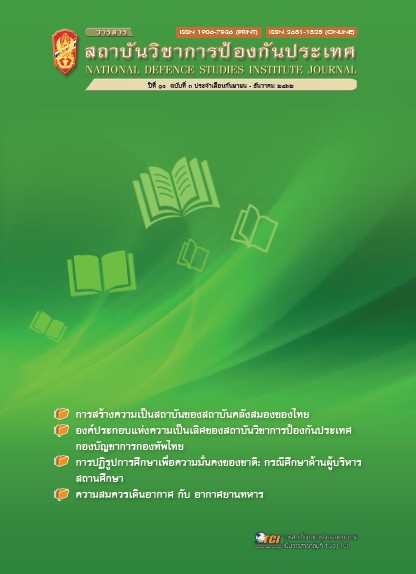The Component of Excellence of National Defence Studies Institute, Royal Thai Armed Forces Headquarter
Main Article Content
Abstract
The objectives of this study were: 1) to analyze and examine the component of excellence
of National Defence Studies Institute. And 2) to suggest ways to develop the components
of excellence of the National Defence Studies Institute under The 20-year National strategy
and Government 4.0. The research methodology is Explanatory sequential mixed methods research.
The research was divided into 2 phases: phase 1 quantitative approach and phase 2 qualitative
approach. The samples used in the quantitative research were 248 commissioned officers of NDSI.
The qualitative research Conducted in-depth interviews of 9 people and 7 focus group discussion
from Strategic experts, Public Sector Development and stakeholders from the Army, Navy and Air
Force. The research instruments consisted of a Questionnaire for confirmatory factor analysis
and the guidelines for in-depth interviews and focus group discussions.
The research found that the component of excellence of National Defence Studies Institute
composed of Leadership, Strategic Planning, Customer Focus, Measurement Analysis, and Knowledge Management, Human Resource Focus, Process Management, Results, and the model is representative and consistent with the empirical data. The qualitative research shows that the National Defence Studies Institute Action Plan is consistent with the Action Plan of Royal Thai Armed Forces Headquarter that are linked and in line with the 20-year national strategy and government 4.0. With suggestions for research by improving
human resource management, The use of good governance, The use of information technology throughout the working process. Add strategic issues based on PMQA indicators, which will help them become more effective in becoming a high performance organization.
Article Details
The articles, images, tables, graphs, written content, and opinions published in this journal are solely those of the authors and do not necessarily reflect the views or positions of the National Defence Studies Institute or its academic affiliates.
References
กระทรวงกลาโหม. (๒๕๔๕). คำสั่งกระทรวงกลาโหม (เฉพาะ) ที่ ๒๒๐/๔๕ เรื่อง นโยบายด้านการศึกษา กระทรวงกลาโหม.
๒๐ กรกฎาคม ๒๕๔๕.
กองทัพไทย. (๒๕๕๑). คำสั่งกองทัพไทย (เฉพาะ) ที่๕๕/๕๑ เรื่อง นโยบายการศึกษาของกองทัพไทย. ๑๘ เมษายน ๒๕๕๑.
นงลักษณ์ วิรัชชัย. (๒๕๔๒). โมเดลลิสเรล สถิติวิเคราะห์สำหรับการวิจัย (พิมพ์ครั้งที่ ๓). กรุงเทพฯ: สำนักพิมพ์
แห่งจุฬาลงกรณ์มหาวิทยาลัย
นงลักษณ์ วิรัชชัย. (๒๕๕๕). การวิเคราะห์องค์ประกอบเชิงยืนยัน. วารสารวิจัยและพัฒนาหลักสูตร, ๒(๑), ๖๘-๗๔.
พระราชกฤษฎีกาว่าด้วยหลักเกณฑ์และวิธีการบริหารกิจการบ้านเมืองที่ดี พ.ศ.๒๕๖๒. (๒๕๖๒, ๓๐ เมษายน).
ราชกิจจานุเบกษา เล่ม ๑๓๖ ตอนที่ ๕๖ ก, หน้า ๒๕๓-๒๕๖.
พระราชบัญญัติการจัดทำยุทธศาสตร์ชาติ พ.ศ.๒๕๖๐. (๒๕๖๐, ๓๑ กรกฎาคม) ราชกิจจานุเบกษา เล่ม ๑๓๔ ตอนที่ ๗๙ ก,
หน้า ๑-๑๒.
พระราชบัญญัติยุทธศาสตร์ชาติ พ.ศ.๒๕๖๑-๒๕๘๐. (๒๕๖๑, ๑๓ ตุลาคม). ราชกิจจานุเบกษา เล่ม ๑๓๕ ตอนที่ ๘๒ ก.
วรเดช จันทรศร. (๒๕๕๙). ทฤษฎีการนำนโยบายสาธารณะไปปฏิบัติ (พิมพ์ครั้งที่ ๗). กรุงเทพฯ: พริกหวานกราฟฟิค.
วิจารณ์ พานิช. (๒๕๔๙). การจัดการความรู้ฉบับนักปฏิบัติ (พิมพ์ครั้งที่ ๓). กรุงเทพฯ: สำนักพิมพ์สุขภาพใจ.
ศรีสุดา วงศ์วิเศษกุล. (๒๕๕๘). การพัฒนายุทธศาสตร์องค์การที่มีขีดสมรรถนะสูงของสถาบันการศึกษาพยาบาล สังกัด
สำนักงานคณะกรรมการการอุดมศึกษา (ดุษฎีนิพนธ์ครุศาสตรดุษฎีบัณฑิต). จุฬาลงกรณ์มหาวิทยาลัย.
สร้อยตระกูล (ติวยานนท์) อรรถมานะ. (๒๕๕๓). พฤติกรรมองค์การ; ทฤษฎีและการประยุกต์ (พิมพ์ครั้งที่ ๔). กรุงเทพฯ:
สำนักพิมพ์มหาวิทยาลัยธรรมศาสตร์.
สำนักงานคณะกรรมการพัฒนาระบบราชการ และสถาบันเพิ่มผลผลิตแห่งชาติ. (๒๕๔๘). คู่มือการจัด การความรู้: จากทฤษฎี
สู่การปฏิบัติ. กรุงเทพฯ: บริษัทวิชั่น พริ้นท์ แอนด์ มีเดีย จำกัด.
สำนักงานคณะกรรมการพัฒนาระบบราชการ. (๒๕๕๓). คู่มือคำอธิบายตัวชี้วัดการพัฒนาคุณภาพการบริหารจัดการภาครัฐ
ปีงบประมาณ พ.ศ.๒๕๕๔. กรุงเทพฯ: วิชั่น พริ้นท์ แอนด์ มีเดีย จำกัด.
สุภางค์ จันทวานิช. (๒๕๕๗). วิธีการวิจัยเชิงคุณภาพ (พิมพ์ครั้งที่ ๒๒). กรุงเทพฯ: สำนักพิมพ์จุฬาลงกรณ์มหาวิทยาลัย.
เสรี ชัดแช้ม. (๒๕๔๗). การวิเคราะห์องค์ประกอบเชิงยืนยัน CONFIRMATORY FACTOR ANALYSIS. วารสารวิธีวิจัยและ
วัดผลการศึกษา, ๒(๑).
เสาวภา เมืองแก่น. (๒๕๖๑). องค์ประกอบของการจัดการองค์การแห่งความเป็นเลิศของมหาวิทยาลัยเอกชนไทย.
วารสารวิชาการมหาวิทยาลัยธนบุรี, ๑๒(๒๘).
Blanchard, K. (2015). Leading at a Higher Level. Sixteenth Printing. Pearson Education LTD.
Byrne BM. (2010). Structural equation modeling with AMOS: Basic concepts, applications, and
programming (2th ed.). New York: Routledge.
Creswell, John W. (2014). Research design: qualitative, quantitative, and mixed methods approaches
(4th ed.). Chapter 10. Mixed Methods Procedures.
Cummings, T. G., & Worley, C. G. (2005). Organization Development & Change (9th ed.). South-Western
Cengage Learning.
De Waal, A. A. (2007). The Characteristics of High Performance Organization. Business Strategy Series,
(3), 179-185.
Hair, J. F., Black, W. C., Bain, B. J., Anderson, R. E., and Tatham, R. L. (2006). Multivariate data analysis
(6th ed.). Upper Saddle River. NJ: Pearson Education International. Joreskog, K. G., and Sorbom, D.
(1996). LISREL 8 user's reference guide. Chicago, IL: Scientific Software International. Mehrens, W.
and Lehmann, I. (1973). Measurement and Evaluation in Education and Psychology. New York:
Holt, Rinehart & Winston.
Holbeche, L. (2005). The High Performance Organization: Creating dynamic stability and sustainable
success.
Krejcie, R. V., & Morgan, D.W. (1970). Determining sample size for research activities. Psycholological
measurement, 30(3), 607-610.
Lawler, E. (2001). Designing High Performance Organizations. Center for Effective Organizations,
Marshall School of Business University of Southern California.
Mayring, P. (2001). Qualitative content analysis. Forum Qualitative Social Research. Retrieved March 4,
, from http://qualitative-research.net/fqs/fqs-e/2-00inhalt-e.htm
McLean, G. N. (2006). Organization Development: Principles, Processes, Performance. San Francisco:
Berrett-Koehler
Miles, M. B., & Huberman, A. M. (1994). Qualitative data analysis (2nd ed). Thousand Oaks: SAGE
Publications.
Miller, L. (2001). The High-Performance Organization: An Assessment of Virtues And Values. The European
Bahá’í Business Forum.
Muldrow, T., Buckley, T. and Schay, B. (2002). Creating High-Performance Organizations in The Public
Sector. Human Resource Management, 41(3), 341-354.
Nunnally, J. C. (1978). Psychometric theory (2nd ed.). New York: McGraw-Hill.
Williamson, T., & Long, A. F. (2005). Qualitative data analysis using data display. Nurse Researcher,
(3), 7-19.


